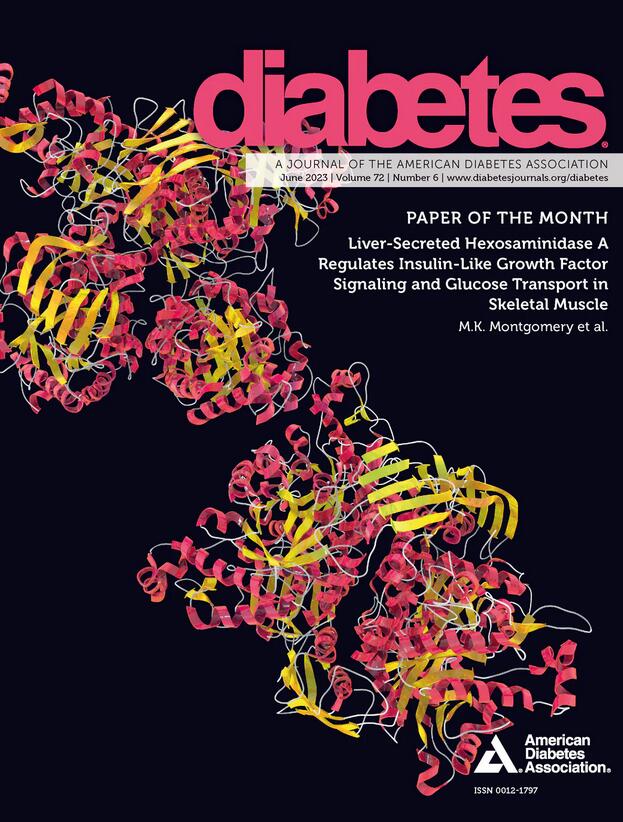评估固定时间间隔内1型糖尿病预防试验结果的新方法
IF 7.5
1区 医学
Q1 ENDOCRINOLOGY & METABOLISM
引用次数: 0
摘要
我们评估了从基线到随机化后1年的二元代谢变化终点(Δ)在1型糖尿病(T1D)预防试验中是否有用。利用最近abatacept预防试验的1期参与者和观察性TrialNet预防途径(PTP)研究的类似参与者的2小时口服葡萄糖耐量测试数据,我们评估了Δmetabolic措施,绘制了葡萄糖和c肽反应曲线,并将Δ从基线到1年的载体分类为代谢治疗失败与成功。使用teplizumab预防研究验证了分析。PTP参与者Δglucose &;gt;0和ΔC-peptide &;lt;从基线到1年的3期T1D风险明显高于Δglucose &;lt;0和ΔC-peptide &;gt;0 (P < 0.0001)。基于此,我们比较了两项试验中安慰剂组与治疗组在1年后的失败(Δglucose >;0与ΔC-peptide &;lt;0)与成功(Δglucose <;0与ΔC-peptide &;gt;0)。使用这个终点,治疗12个月后发现阿巴接受有良好的代谢影响。在固定的时间间隔内,使用失败与成功的二元代谢终点的分析方法似乎至少可以检测到治疗效果以及较短随访时间的标准主要终点。1型糖尿病(T1D)预防试验设计的及时挑战可能产生负面结果,即使治疗可能实际上改善疾病病理。我们评估了随机化后12个月从基线到1年的二元代谢终点是否可用于T1D预防试验。该方法在随访时间较短的情况下检测到治疗效果至少与标准主要终点一样好。固定间隔代谢终点应与传统T1D终点联合使用,以便更好地了解预防药物的治疗效果。本文章由计算机程序翻译,如有差异,请以英文原文为准。
Novel Approach for Assessing Outcomes of Type 1 Diabetes Prevention Trials Over a Fixed Time Interval
We evaluated whether a binary metabolic end point for change (Δ) from baseline to 1-year postrandomization could be useful in type 1 diabetes (T1D) prevention trials. Using 2-h oral glucose tolerance testing data from the stage 1 participants in the recent abatacept prevention trial and similar participants in the observational TrialNet Pathway to Prevention (PTP) study, we assessed Δmetabolic measures, plotted glucose and C-peptide response curves, and categorized vectors for Δ from baseline to 1 year as metabolic treatment failure versus success. Analyses were validated using the teplizumab prevention study. PTP participants with Δglucose >0 and ΔC-peptide <0 from baseline to 1 year were at substantially higher risk for stage 3 T1D than those with Δglucose <0 and ΔC-peptide >0 (P < 0.0001). Based on this, we compared placebo versus treatment groups in both trials for failure (Δglucose >0 with ΔC-peptide <0) versus success (Δglucose <0 with ΔC-peptide >0) after 1 year. Using this endpoint, a favorable metabolic impact of abatacept was found after 12 months of treatment. An analytic approach using a binary metabolic end point of failure versus success at a fixed time interval appears to detect treatment effects at least as well as standard primary end points with shorter follow-up. ARTICLE HIGHLIGHTS Challenges in time to event type 1 diabetes (T1D) prevention trial design can yield negative results even for treatments that may actually improve disease pathology. We evaluated whether a binary metabolic end point for 12-month change from baseline to 1 year postrandomization could be useful in T1D prevention trials. This approach detected treatment effects at least as well as standard primary end points with shorter follow-up. Fixed interval metabolic end points should be used in combination with traditional T1D end points to better understand treatment effects of preventive agents.
求助全文
通过发布文献求助,成功后即可免费获取论文全文。
去求助
来源期刊

Diabetes
医学-内分泌学与代谢
CiteScore
12.50
自引率
2.60%
发文量
1968
审稿时长
1 months
期刊介绍:
Diabetes is a scientific journal that publishes original research exploring the physiological and pathophysiological aspects of diabetes mellitus. We encourage submissions of manuscripts pertaining to laboratory, animal, or human research, covering a wide range of topics. Our primary focus is on investigative reports investigating various aspects such as the development and progression of diabetes, along with its associated complications. We also welcome studies delving into normal and pathological pancreatic islet function and intermediary metabolism, as well as exploring the mechanisms of drug and hormone action from a pharmacological perspective. Additionally, we encourage submissions that delve into the biochemical and molecular aspects of both normal and abnormal biological processes.
However, it is important to note that we do not publish studies relating to diabetes education or the application of accepted therapeutic and diagnostic approaches to patients with diabetes mellitus. Our aim is to provide a platform for research that contributes to advancing our understanding of the underlying mechanisms and processes of diabetes.
 求助内容:
求助内容: 应助结果提醒方式:
应助结果提醒方式:


